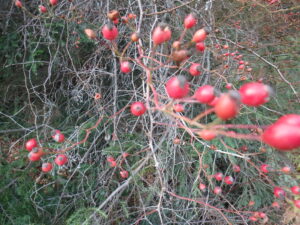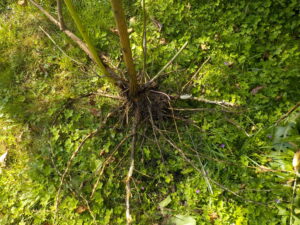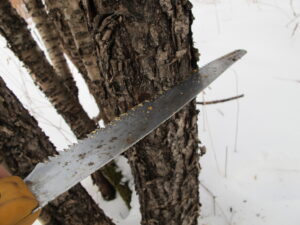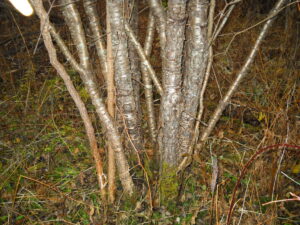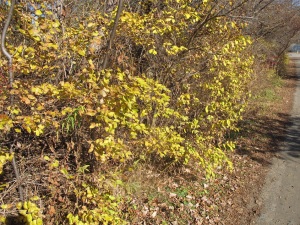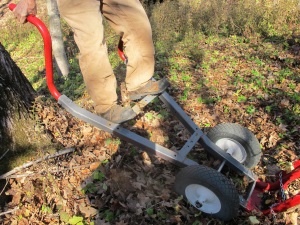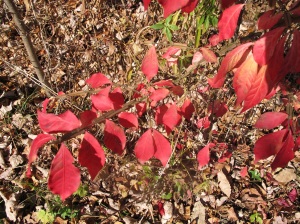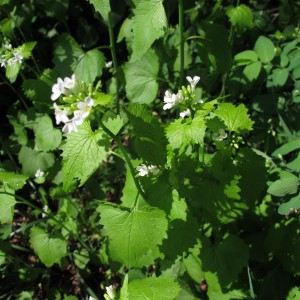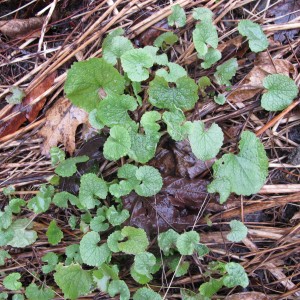Invasives: What are they? What can you do about them?
Multiflora roses just showed up on my property last year, probably by birds that dropped seeds. It is easy to see roses growing in your woods or fields, or even in a garden bed and pass it by as “just a rose”. But the roses we love don’t just appear.
First, I dress appropriately: jeans, long-sleeved shirt, a hat with a brim, and heavy winter leather work gloves. This culprit wants to hurt anyone trying to uproot it. I cut off the branches, just leaving a foot or so to grab onto when pulling it out. Then I loosen the soil and pull weeds around it. The roots radiate outward from the stem like spokes on a bike. I loosen each root and tug gently when they are small enough to remove.
I’ve read that just cutting back the stems to ground level will stimulate the roots to send up new shoots everywhere, causing a bigger problem. There is no easy answer. Invasive plants are always difficult to remove – usually a scrap of root can generate a new plant – or several.
Since buckthorn are often multi-stemmed, it can be difficult to use that method. Do it up high enough that you can get your saw in between the stems. But I’ve done it, and it works.
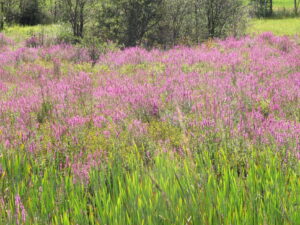 As regular readers of this column k now, I only use organic techniques in the garden. This means no chemicals including herbicides. From what I have read, most herbicides will not kill the invasives mentioned in this article. They will set them back considerably, depending on the age of the plant and the dose of the chemical. But learning to recognize all the invasives is best. And if one appears on your landscape, get rid of it immediately! And remember, persistence is important
As regular readers of this column k now, I only use organic techniques in the garden. This means no chemicals including herbicides. From what I have read, most herbicides will not kill the invasives mentioned in this article. They will set them back considerably, depending on the age of the plant and the dose of the chemical. But learning to recognize all the invasives is best. And if one appears on your landscape, get rid of it immediately! And remember, persistence is importantInvasive Plants
Going for a walk the other day along a public trail I was struck by the number of invasive shrubs I saw. Most trees and shrubs have shed their leaves, but burning bush (Euonymus alatus), Japanese barberry (Berberis thunbergii) and honeysuckle (Lonicera spp.) still have leaves on their branches. Holding leaves and producing food by photosynthesis gives them extra energy to take over the world (or their world, anyway). This is a good time to pull a few of these out because many are very visible right now.
Why bother, you might ask? Because these invasive plants which come from the China or Japan have no natural enemies here. Left alone, they can take over the landscape, outcompeting our native wildflowers and understory shrubs, although that may take decades. In some places they have created monocultures by elbowing out other plants. Most birds, mammals and insects have evolved while depending on native species for their food and shelter. Do these shrubs provide food? Yes, but it is often not of the same quality as that of our native species.
Cutting down invasive shrubs will not necessarily kill them. Some invasive trees and shrubs react by sending up multiple new shoots from their roots. Instead of one buckthorn, for example, you suddenly have several in a circle around the tree you cut down. That increases the problem instead of solving it.
I have found that buckthorns can be killed without producing the root suckers if I double girdle the tree. By this I mean I cut a ring around the tree with a pruning saw, and then cut another ring a foot higher or lower than the first cut. I cut through the bark and the green cambium layer, but do not cut into the heartwood. If I do this now, the tree will leaf out next spring and the following spring, but slowly die by the third year. Patience is the key. The technique allows you to slowly starve the roots – they can’t get any nutrition from the leaves. Many buckthorns have multiple stems, and you must girdle every one to kill the roots.
For small to medium sized invasive trees and shrubs, pulling them up is another option. I recently met with Gerry Hawkes, an inventor and forester in Woodstock, Vermont to try out a tool he developed to pull invasives (and do other tasks such as hauling firewood and moving large stones). It is a sturdy, 2-wheeled device that uses leverage to pull up a tree, roots and all. We pulled an inch-and-a-half buckthorn tree and a full size multi-stemmed honeysuckle with a trunk that was over three inches in diameter at the base.
The tool we used is called a Wheeled Post and Shrub Puller (http://
We looped a light chain around the base of the tree and then attached it to one of four notches on the puller to allow us to begin with the best mechanical advantage, which is 12:1. I pulled down on the handle using my weight and it lifted the buckthorn partially out of the ground. Then, to get an even higher lift, we reset the chain to a different notch on the front of the tool and I got the root system right out of the ground! Since this tool is on 16 inch wheels, I was able to roll the tree away with little effort.
I have also used a hand tool called a Weed Wrench that pulls small trees and shrubs. Unfortunately, the company that makes these tools has gone out of business. It was made in four sizes with a gripping mouth-part that clamps down on a trunk, and a handle that uses leverage to pry out shrubs. Two other companies are now marketing similar tools, The Uprooter (www.theuprooter.com) and the Pullerbear (www.pullerbear.com). From what I have read, neither would compete with the tool I tried last week for pulling larger shrubs and small trees.
I think that using mechanical advantage to pull invasives makes much more sense than using chemical herbicides. But I don’t have personal experience following up over several years with invasives pulled: will the scraps of roots left in the ground survive and re-sprout? It’s possible that they will. Still, I think that Conservation Commissions and Garden Clubs would be well served by investing in pulling devices to share with interested townspeople and using along public pathways.
There are no plant police. No one can tell you that your invasive shrubs must be pulled up. Nurseries may not sell them, propagate them or transport them. But I am working hard at removing mine. And even if you live in a city, it makes sense to remove invasive plants on your property. Their seeds may wash down storm drains, and end up in a wetland or river – and spread their genetic material.
Getting rid of invasive plants takes time. I recently chatted with a woman who removed all the burning bush on her property 12 years ago. She is still pulling seedlings that germinate from seeds deposited over a decade ago. But, on the positive side, pulling “thugs” gives you more room to plant other nice landscape plants. So go look for invasive plants now, and try to get rid of a few.
Henry Homeyer is a gardening consultant and coach. He speaks to garden clubs and civic organizations about many aspects of gardening. Contact him at henry.homeyer@comcast.net or visit his website, www.Gardening-Guy.com.
Garlic Mustard
As a garden writer I get a lot of email from people warning me about pending catastrophes: blights, bugs, invasive plants. Some are accurate, some are not. In 2012 we were told that a disease kills Impatiens (a lovely annual flower for shade) would make growing it impossible – ever again. But last year it did fine for many gardeners. Late blight on tomatoes is predicted every year, but my tomatoes have only been affected once. But I recently learned some disturbing news about an invasive weed, garlic mustard (Alliaria petiolata), that we should all pay attention to.
Invasive plants generally out-compete our native plants because they grow anywhere, often putting out leaves earlier in the spring than our natives, and holding them longer in the fall. Some, like the Norway maple, have roots that suck up water and nutrients far from the mother plant. Others, like barberry or honeysuckle, shade out natives in the understory of the forest. But garlic mustard, a seemingly innocuous little weed with a root system that is not hard to pull, goes one step beyond the others: it produces a toxin that kills necessary root-coating fungi on our maples, oaks and beeches. Where it grows, some of our favorite trees are in danger.
You may know that mycorrhizal fungi are beneficial fungi that coat the fine root hairs of many trees and perennial plants. They get sugars from the green plants and, as payback, share minerals that the green plants need but can’t extract from the minerals in their natural state. The mycorrhizal fungi produce acids that dissolve minerals in the soil and make them into a form that is readily taken up by the green plants. It’s a perfect symbiotic relationship: you scratch my back, I’ll scratch yours.
Here’s the bad news: Garlic mustard kills mycorrhizal fungi by producing chemicals and releasing them into the soil. Maples, oaks and white ash are all trees that depend on mycorrhizal fungi to succeed. Not only that, garlic mustard inhibits the germination of seeds of many species of native plants, including many spring wildflowers. And it has no natural predators here in the United States where it has invaded from Europe. In Europe it has at least 69 insect predators. Garlic mustard produces chemicals that make it uninteresting as food to herbivores like deer, as well as to insect predators.
So what can we do? First, understand its life cycle and learn to identify it. Garlic mustard is a biennial, meaning that it has a 2-year life cycle. In the first year it produces a low rosette of rounded leaves. The second year it sends up 18- to 36-inch flower spikes with pointy, heart-shaped leaves with jagged edges. The small white flowers have 4 petals and bloom in clusters about an inch or more in diameter. One plant can produce about 4,000 seeds. And although about 70% of the seeds will germinate the next year, some will remain viable in the soil for up to 10 years. A Web site full of good information is http://www.invasivespeciesinfo.gov/plants/garlicmustard.shtml.
Garlic mustard leaves when crushed smell a bit like garlic. Not as strong, but it has a distinct odor. The Europeans that brought it here in the 1860’s often grew it as an herb or a garlic substitute, and I have tasted pesto made from the leaves. But since it produces cyanide at a level much higher than other plants, I choose not to consume it. I figure that if the deer won’t eat it, I won’t either.
Here’s the good news: pulling up garlic mustard is easy. It has a white tap root that comes right out if you give it a tug. It is not like many pest weeds – it doesn’t spread by roots that easily break off and start new plants. Goutweed, Japanese knotweed and witch grass all spread by root, but garlic mustard does not. After pulling it, place garlic mustard in the household trash, not the compost pile. Or if you must, seal it in black plastic bags and let it rot in the sun until full decomposed.
How can you help to prevent its spread? Pull it if you see it. Watch for first year plants – it sometimes arrives in hay used for erosion control – it will grow in full sun or full shade. A good close mowing of plants will help, though one report I read said that garlic mustard cut at 10 cm (roughly 4 inches) would survive 29% of the time.
Garlic mustard is blooming right now! So go look for it. Organize a neighborhood group for a “pulling party”. It behooves us all to look out for it, and to do our best to reduce its numbers and prevent its spread.
Henry Homeyer can be reached at henry.homeyer@comcast.net. He is the author of 4 gardening books and a children’s chapter book about a boy and a cougar. His website is www.Gardening-guy.com.



